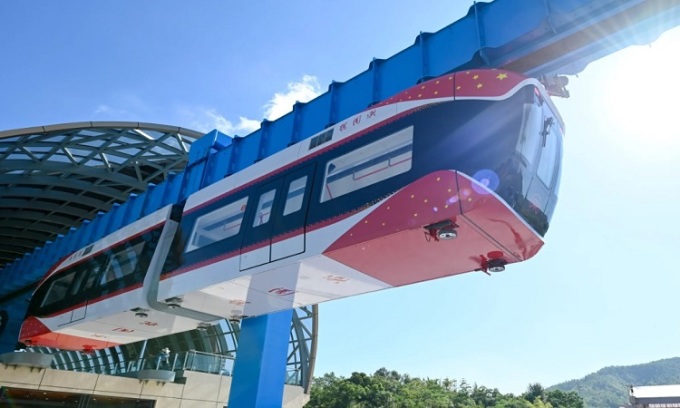China is testing the world's first suspended maglev train, which hovers high and carries passengers at speeds of 120 km/h.

Red Rail maglev train test run in Jiangxi from early April 2023. Photo: VCG
The 800-meter-long Red Rail test track in Xingguo County, Jiangxi Province, uses rare-earth magnets to create a permanent thrust strong enough to lift the 88-passenger train into the air, Business Insider reported on April 29. Unlike most current maglev trains, the suspended train operates about 10 meters above the ground. The train travels below at a speed of 80 km/h instead of directly contacting the rails.
Permanent magnets on both the rails and the shafts that protrude from the train repel each other, keeping the train suspended. With free-floating, frictionless conditions, only a small amount of electricity is needed to propel the train, according to a team at Jiangxi University of Science and Technology. The new maglev technology produces very little electromagnetic radiation and costs only one-tenth as much to build as a subway. Local transport authorities say that after several test runs, the line will be expanded to 7.5 kilometers (4.5 miles) and the maximum operating speed will be 120 kilometers per hour (75 mph).
Several cities in China are planning or promoting the construction of maglev lines. Some trains can travel as fast as 600 km/h. But most projects use electric power to propel themselves, which not only increases electricity consumption but also creates strong electromagnetic fields that can affect the environment and the health of people living nearby. Ordinary magnets with opposite poles repel each other, but their magnetic strength gradually decreases over time. Adding rare earth elements to magnets can significantly increase their lifespan. For example, neodymium can reduce the rate of magnetic force decay to less than 5% over a century. Magnets containing rare earth elements are therefore also called permanent magnets.
China has long planned to build a permanent magnet maglev line and has supported several research projects since 2011. Suspended maglev technology has many challenges, such as maintaining the balance of the train in a suspended state without electricity. However, Chinese researchers have made many breakthroughs in recent years in train control and operational safety through the use of new technology, including artificial intelligence (AI).
Long Zhiqiang, a professor at the National Defense University in Changsha, Hunan, and a member of the Red Line project, said that the permanent magnet maglev train is superior to underground trains in terms of speed and comfort. The maximum speed of most underground railways in China is limited to 80 km/h, but the permanent magnet maglev train, which is fully controlled by AI, can run 50% faster. This means that even in crowded city centers, the train can maintain its speed and provide passengers with a wide view, avoiding traffic jams and enjoying the scenery along the way. The vehicle also runs more smoothly even at high speeds due to the absence of magnetic pollution.
According to Long, the train is unlikely to malfunction or break down during long-term operation because the permanent magnetic field can absorb most of the shock. "The permanent magnet maglev train offers a smart and personalized form of transportation that can complement subways and urban rail," Long said.
An Khang (According to Business Insider/SCMP )
Source link



































































































Comment (0)